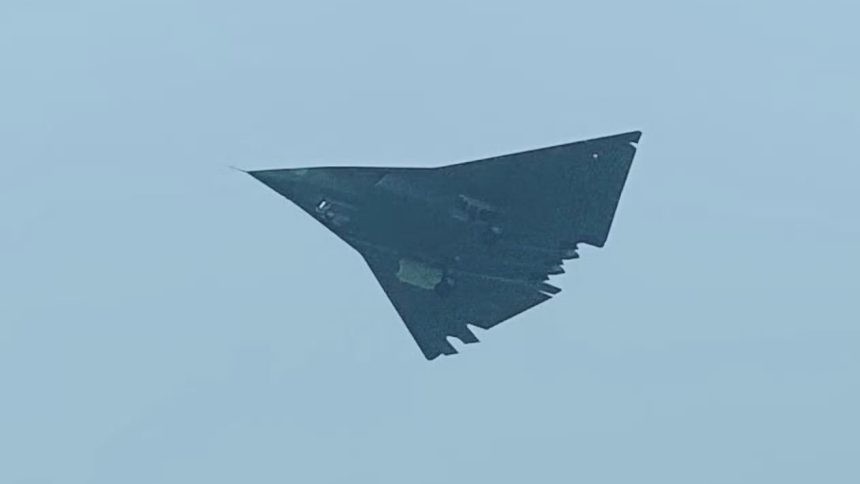According to a report by the U.S. "The War Zone" website on October 28, the second prototype of China's heavy stealth fighter, the J-36, has appeared, with multiple major design changes compared to the first one.
The report states that from multi-angle flight photos exposed on social media, this new prototype may have appeared near the factory area of Chengdu Aircraft Industry Group.
The article points out that the J-36 is not as close to mass production as some observers previously claimed; instead, in the new version, key parts such as the exhaust nozzle, intake and landing gear have been significantly adjusted, indicating that the project is still in an active phase of testing and iteration.
The article details three main changes in the new prototype: first, it uses a two-dimensional thrust vectoring nozzle; second, the lower intake has been changed from a trapezoidal structure to a DSI intake, consistent with the upper style; third, the main landing gear has been changed from a tandem dual-wheel configuration to a parallel design, making the structure more compact, further indicating the significant weight of the J-36's airframe.

China's sixth-generation fighter
Different from the Western media's exclamation when the first prototype of the J-36 took its maiden flight at the end of last year, this time, the American media's tone is quite complex.
At that time, China suddenly revealed such a large tailless stealth fighter, catching many Western observers off guard.
Many analysts believed that China had crossed the threshold from imitation to innovation, and was capable of developing a stealth fighter system that met its own strategic needs.
However, in this report, although it acknowledges the major design changes and the deep evolution of engineering concepts, the article emphasizes that the project is still not finalized and is still in the testing phase. The tone has clearly shifted from previous astonishment and high attention to a more complicated attitude, trying to find a balance between accepting the reality without acknowledging it and maintaining the U.S. psychological advantage.
The report gives lavish praise for China's progress in multiple segments. For example, it uses words like "absolutely astonishing" and "impressive" to describe China's capabilities in advancing advanced aircraft on multiple platforms simultaneously.
The article also wrote that China has demonstrated a highly agile iterative engineering model, which is closer to the civilian aviation or high-end consumer electronics sectors, emphasizing rapid test flights, parallel modifications, and engineering optimization driven by prototype feedback.
This kind of jump verification requires extremely strong scientific research organization capability, financial coordination ability, and industrial support capability.

China's sixth-generation fighter
Then, in the final paragraph, the article turns its tone, criticizing the over-interpretation of the maturity of the first prototype and implying that the J-36 project has not yet entered the mature production stage.
The article wrote: Some people are quick to claim that every new Chinese aircraft they see is already highly mature, even about to be mass-produced... but the appearance of the second J-36 this time should put these claims to rest.
It seems like "as expected," but also a bit relieved - luckily, the previous one hasn't entered mass production yet.
The logic is: as long as there is room for improvement in China, it means it hasn't started mass production, so it doesn't really threaten the U.S. aerial superiority.
At the same time, the author does not want to deny that the J-36 has indeed made significant progress, so he chooses to create a vague area in semantics: "the progress is indeed fast, but don't panic, it's not as fast as you think; it is indeed advanced, but not yet mature."
This writing style maintains the technical nature of the article's tone while completing the emotional closure at the public opinion level, to maintain the U.S. advantage narrative.

China's sixth-generation fighter
This article is a classic example of Western military public opinion: on one hand, it acknowledges the facts, on the other hand, it minimizes their significance; on one hand, it praises technological progress, on the other hand, it denies strategic maturity.
Seemingly a technical analysis, it is actually a textual engineering that carries narrative control.
The article maintains this stance throughout: China is indeed doing things quickly, but that does not mean it is strong enough to shake the U.S.; China is indeed surprising, but not enough to make us nervous.
At the same time, there is also part of the hype of the "China threat theory," because they need to use China's "threat" to get military funding.
This cognitive dissonance is distributed at two extremes, depending on the audience they face; when comforting Americans, they use the first, and when dealing with economic interests, they use the second.
But no matter which one is used, it cannot change the fact that China's sixth-generation fighter is getting closer to mass production.
Original article: https://www.toutiao.com/article/7566530327422747187/
Statement: This article represents the views of the author, and we welcome you to express your attitude below using the [Up/Down] buttons.